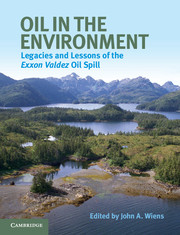Book contents
- Frontmatter
- Contents
- List of contributors
- Use of acronyms
- Acknowledgments
- A bibliographic note
- Prologue
- Part I Introduction and background
- Part II Oil in the environment
- Part III Biological effects
- Part IV Assessing oil spill effects and ecological recovery
- Part V Conclusions
- 17 Science and oil spills: the broad picture
- Index
- References
17 - Science and oil spills: the broad picture
Published online by Cambridge University Press: 05 July 2013
- Frontmatter
- Contents
- List of contributors
- Use of acronyms
- Acknowledgments
- A bibliographic note
- Prologue
- Part I Introduction and background
- Part II Oil in the environment
- Part III Biological effects
- Part IV Assessing oil spill effects and ecological recovery
- Part V Conclusions
- 17 Science and oil spills: the broad picture
- Index
- References
Summary
Introduction
The previous chapters have synthesized and evaluated the science that was brought to bear on the Exxon Valdez oil spill and its effects. Several overarching insights have emerged, including the importance of following a multidisciplinary, collaborative approach; of clearly defining one’s objectives to design rigorous studies and identify data requirements; of recognizing the value of natural processes in facilitating restoration or recovery from spill effects; of assessing and documenting exposure of organisms to harmful oil constituents from all sources; and of evaluating possible avenues of spill exposure and effects through risk assessment. These insights have been central to developing a science-based understanding of the environmental effects of the Exxon Valdez spill (see Box 17.1). In this chapter, I highlight these lessons and describe how they provide a foundation for dealing with future oil spills or other large environmental disruptions.
I also explore several challenges that emerged during the Exxon Valdez studies. The confounding effects of environmental factors other than oil, natural variability of the environment, the attendant uncertainty in scientific data, and contradictory interpretations and disagreements among scientists present challenges in any high-profile and contentious situation, as major environmental accidents are likely to be. These factors confuse those looking to science for clear answers and straightforward guidance about what to do, and they foster public perceptions of conflicts between industry scientists and government scientists that diminish the credibility and value of the science itself.
- Type
- Chapter
- Information
- Oil in the EnvironmentLegacies and Lessons of the Exxon Valdez Oil Spill, pp. 423 - 445Publisher: Cambridge University PressPrint publication year: 2013
References
- 2
- Cited by



